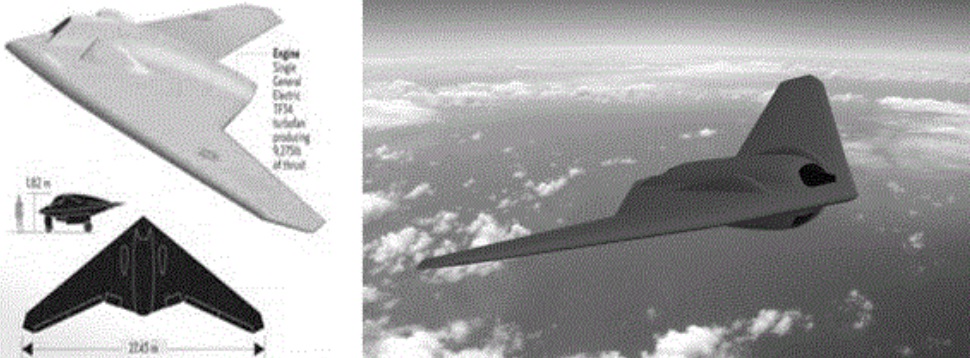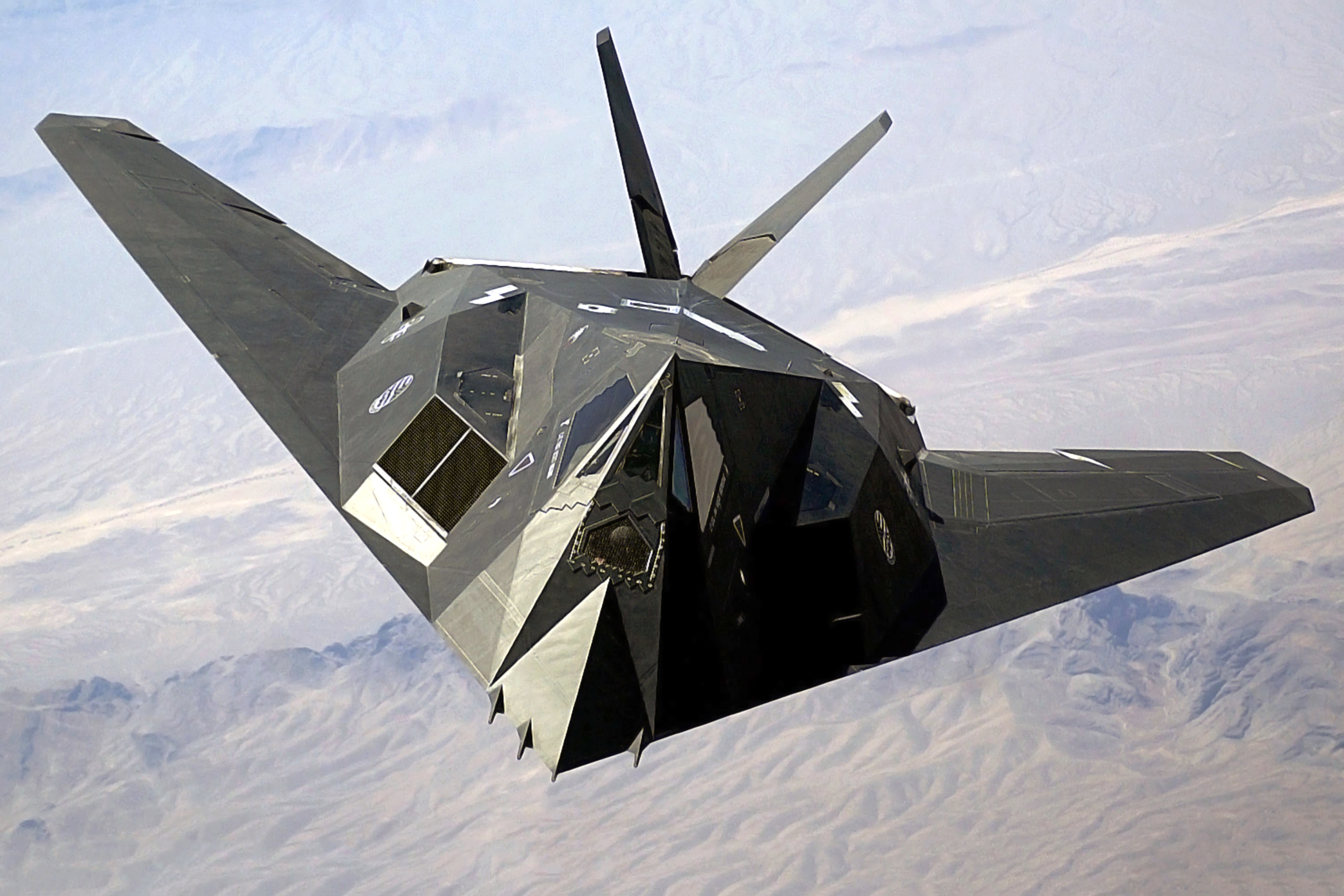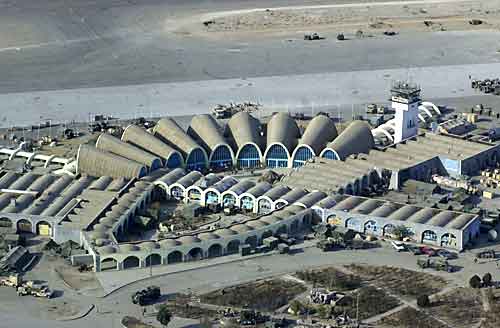|
RQ-170
The Lockheed Martin RQ-170 Sentinel is an American unmanned aerial vehicle (UAV) developed by Lockheed Martin and operated by the United States Air Force (USAF) for the Central Intelligence Agency (CIA). While the USAF has released few details on the UAV's design or capabilities, defense analysts believe that it is a stealth aircraft fitted with aerial reconnaissance equipment. Introduced in 2007, it was deployed to Afghanistan in late 2007, and to South Korea two years later, in September 2009. Some images and details of the aircraft were released after Iran captured an RQ-170 in 2011. It has a flying wing design, and uses a single engine, speculated to be either a General Electric TF34 turbofan or a Garrett TFE731. Development The RQ-170 Sentinel was developed by Lockheed Martin's Skunk Works as a stealth unmanned aerial vehicle (UAV). Journalists have noted design similarities between the RQ-170 and previous stealth and UAV programs such as the RQ-3 DarkStar and Polecat. A ... [...More Info...] [...Related Items...] OR: [Wikipedia] [Google] [Baidu] |
United States Air Force
The United States Air Force (USAF) is the air service branch of the United States Armed Forces, and is one of the eight uniformed services of the United States. Originally created on 1 August 1907, as a part of the United States Army Signal Corps, the USAF was established as a separate branch of the United States Armed Forces in 1947 with the enactment of the National Security Act of 1947. It is the second youngest branch of the United States Armed Forces and the fourth in order of precedence. The United States Air Force articulates its core missions as air supremacy, global integrated intelligence, surveillance and reconnaissance, rapid global mobility, global strike, and command and control. The United States Air Force is a military service branch organized within the Department of the Air Force, one of the three military departments of the Department of Defense. The Air Force through the Department of the Air Force is headed by the civilian Secretary of the Air Force ... [...More Info...] [...Related Items...] OR: [Wikipedia] [Google] [Baidu] |
432d Air Expeditionary Wing
The 432nd Wing is a United States Air Force unit assigned to Air Combat Command at Creech Air Force Base near Indian Springs, Nevada. It flies General Atomics MQ-9 Reaper and RQ-170 Sentinel Unmanned aerial vehicles. The group operates unmanned reconnaissance aircraft which provide real-time reconnaissance, surveillance, and precision attack against fixed and time-critical targets. The 432nd Air Expeditionary Wing is a provisional unit assigned to Air Combat Command and is the designation for components of the 432nd Wing when deployed into combat areas as part of the Global War on Terror. Overview The wing is the first United States Air Force wing dedicated to unmanned aircraft systems: MQ-9 Reaper and RQ-170 Sentinel. The wing stood up 1 May 2007 at Creech Air Force Base, Nevada. The wing has dual reporting responsibilities to Ninth Air Force and U.S. Air Forces Central Command (USAFCENT) (as the 432nd AEW) at Shaw Air Force Base, South Carolina, as well as to Twelfth Air Forc ... [...More Info...] [...Related Items...] OR: [Wikipedia] [Google] [Baidu] |
Flying Wing
A flying wing is a tailless fixed-wing aircraft that has no definite fuselage, with its crew, payload, fuel, and equipment housed inside the main wing structure. A flying wing may have various small protuberances such as pods, nacelles, blisters, booms, or vertical stabilizers. Similar aircraft designs, that are not technically flying wings, are sometimes casually referred to as such. These types include blended wing body aircraft and lifting body aircraft, which have a fuselage and no definite wings. A pure flying wing is theoretically the lowest drag design configuration for a fixed wing aircraft. However, because it lacks conventional stabilizing surfaces and the associated control surfaces, in its purest form the flying wing suffers from being unstable and difficult to control. The basic flying wing configuration became an object of significant study during the 1920s, often in conjunction with other tailless designs. In the Second World War, both Nazi Germany and the A ... [...More Info...] [...Related Items...] OR: [Wikipedia] [Google] [Baidu] |
Aerial Reconnaissance
Aerial reconnaissance is reconnaissance for a military or strategic purpose that is conducted using reconnaissance aircraft. The role of reconnaissance can fulfil a variety of requirements including artillery spotting, the collection of imagery intelligence, and the observation of enemy maneuvers. History Early developments After the French Revolution, the new rulers became interested in using the balloon to observe enemy manoeuvres and appointed scientist Charles Coutelle to conduct studies using the balloon ''L'Entreprenant'', the first military reconnaissance aircraft. The balloon found its first use in the 1794 conflict with Austria, where in the Battle of Fleurus they gathered information. Moreover, the presence of the balloon had a demoralizing effect on the Austrian troops, which improved the likelihood of victory for the French troops. To operate such balloons, a new unit of the French military, the French Aerostatic Corps, was established; this organisatio ... [...More Info...] [...Related Items...] OR: [Wikipedia] [Google] [Baidu] |
Lockheed Martin Polecat
The Lockheed Martin Polecat (company designation P-175) was an unmanned aerial vehicle by Lockheed Martin. It was developed by the company's Advanced Development Programs division in Palmdale, California. Design and development Designated P-175, the Polecat was funded internally by Lockheed Martin (as opposed to using United States Government funds) at the beginning of 2005. The prototype was unveiled at the 2006 Farnborough Airshow.Farnborough picture: Lockheed Martin Skunk Works releases picture of secret Polecat UAV " '' |
Stealth Aircraft
Stealth aircraft are designed to avoid detection using a variety of technologies that reduce reflection/emission of radar, infrared, visible light, radio frequency (RF) spectrum, and audio, collectively known as stealth technology. The F-117 Nighthawk was the first operational aircraft specifically designed around stealth technology. Other examples of stealth aircraft include the B-2 Spirit, the B-21 Raider, the F-22 Raptor, the F-35 Lightning II, the Chengdu J-20, and the Sukhoi Su-57. While no aircraft is totally invisible to radar, stealth aircraft make it more difficult for conventional radar to detect or track the aircraft effectively, increasing the odds of an aircraft successfully avoiding detection by enemy radar and/or avoiding being successfully targeted by radar guided weapons. Stealth is the combination of passive low observable (LO) features and active emitters such as low-probability-of-intercept radars, radios and laser designators. These are usually combined ... [...More Info...] [...Related Items...] OR: [Wikipedia] [Google] [Baidu] |
Skunk Works
Skunk Works is an official pseudonym for Lockheed Martin's Advanced Development Programs (ADP), formerly called Lockheed Advanced Development Projects. It is responsible for a number of aircraft designs, beginning with the Lockheed P-38 Lightning, P-38 Lightning in 1939 and the Lockheed P-80 Shooting Star, P-80 Shooting Star in 1943. Skunk Works engineers subsequently developed the Lockheed U-2, U-2, Lockheed SR-71 Blackbird, SR-71 Blackbird, Lockheed F-117 Nighthawk, F-117 Nighthawk, Lockheed Martin F-22 Raptor, F-22 Raptor, and Lockheed Martin F-35 Lightning II, F-35 Lightning II, the latter being used in the air force, air forces of several countries. The Skunk Works name was taken from the "Skonk Oil" factory in the comic strip ''Li'l Abner''. The designation Skunkworks project, "skunk works" or "skunkworks" is widely used in business, engineering, and technical fields to describe a group within an organization given a high degree of autonomy and unhampered by bureaucracy, ... [...More Info...] [...Related Items...] OR: [Wikipedia] [Google] [Baidu] |
Garrett TFE731
The Garrett TFE731 (now Honeywell TFE731) is a family of geared turbofan engines commonly used on business jet aircraft. Garrett AiResearch originally designed and built the engine, which due to mergers was later produced by AlliedSignal and now Honeywell Aerospace. Since the engine was introduced in 1972, over 11,000 engines have been built, flying over 100 million flight-hours. Development The TFE731 was based on the core of the TSCP700, which was specifically developed for use as the auxiliary power unit (APU) on the McDonnell Douglas DC-10. The design featured two important factors: low fuel consumption, and low noise profiles that met the newly established U.S. noise abatement regulations. The first test run of the TFE731 occurred in 1970 at Garrett's plant in Torrance, California. The first production model, the TFE731-2, began rolling off the assembly line in August, 1972, and was used on the Learjet 35/36 and Dassault Falcon 10, both of which entered production in 1 ... [...More Info...] [...Related Items...] OR: [Wikipedia] [Google] [Baidu] |
General Electric TF34
The General Electric TF34 is an American military turbofan engine used on the A-10 Thunderbolt II and S-3 Viking. Design and development Developed by GE Aircraft Engines during the late 1960s, the original engine comprises a single stage fan, driven by a 4-stage low pressure (LP) turbine, supercharging a 14-stage high pressure (HP) compressor, driven by a 2-stage HP turbine. An annular combustor is featured. The TF34-GE-400A is rated at 9,275 lbf (41.26 kN) static thrust. The civilian variant, the CF34, is used on a number of business and regional jets. Variants ;TF34-GE-2 Initial variant for Lockheed S-3, entered production in August 1972. ;TF34-GE-100 Variant for Fairchild A-10A, first flown in A-10 during May 1972. Production began in October 1974. ;TF34-GE-400A Improved version of GE-2 for Lockheed S-3. Applications * Fairchild Republic A-10 Thunderbolt II * Lockheed S-3 Viking * Lockheed Martin RQ-170 Sentinel * Sikorsky S-72 Specifications (TF34-GE-40 ... [...More Info...] [...Related Items...] OR: [Wikipedia] [Google] [Baidu] |
RQ-3 DarkStar
The RQ-3 DarkStar (known as Tier III- or "Tier three minus" during development) is an unmanned aerial vehicle (UAV). Its first flight was on March 29, 1996. The Department of Defense terminated DarkStar in January 1999, after determining the UAV was not aerodynamically stable and was not meeting cost and performance objectives. Design and development The RQ-3 DarkStar was designed as a "High-Altitude Long Endurance, high-altitude endurance UAV", and incorporated stealth aircraft technology to make it difficult to detect, which allowed it to operate within heavily defended airspace, unlike the Northrop Grumman RQ-4 Global Hawk, which is unable to operate except under conditions of air supremacy. The DarkStar was fully autonomous: it could take off, fly to its target, operate its sensors, transmit information, return and land without human intervention. Human operators, however, could change the DarkStar's flight plan and sensor orientation through radio or satellite relay. The R ... [...More Info...] [...Related Items...] OR: [Wikipedia] [Google] [Baidu] |
Stealth Aircraft
Stealth aircraft are designed to avoid detection using a variety of technologies that reduce reflection/emission of radar, infrared, visible light, radio frequency (RF) spectrum, and audio, collectively known as stealth technology. The F-117 Nighthawk was the first operational aircraft specifically designed around stealth technology. Other examples of stealth aircraft include the B-2 Spirit, the B-21 Raider, the F-22 Raptor, the F-35 Lightning II, the Chengdu J-20, and the Sukhoi Su-57. While no aircraft is totally invisible to radar, stealth aircraft make it more difficult for conventional radar to detect or track the aircraft effectively, increasing the odds of an aircraft successfully avoiding detection by enemy radar and/or avoiding being successfully targeted by radar guided weapons. Stealth is the combination of passive low observable (LO) features and active emitters such as low-probability-of-intercept radars, radios and laser designators. These are usually combined ... [...More Info...] [...Related Items...] OR: [Wikipedia] [Google] [Baidu] |
Kandahar Airfield
Ahmad Shah Baba International Airport, also referred to as Kandahar International Airport ( ps, د کندهار نړيوال هوايي ډګر) and by some military officials as Kandahar Airfield, KAF) , is located about south-east of the city Kandahar in Afghanistan. It serves as the nation's second main international airport and as one of the largest main operating bases, capable of housing up to 250 aircraft of different sizes. The current head of the airport is Maulvi Fathullah Mansour. The airport was designed and built by the United States in the early 1960s. It was occupied by the Soviets during the 1980s Soviet–Afghan War. Following their withdrawal the airport remained in control of Najibullah's government until he stepped down in 1992. Thereafter, local warlords and the Taliban took control of the airport until the American invasion in late 2001. It was also the site of Airstan incident in 1995, as well as the Indian Airlines Flight 814 incident in 1999. Since 2007 ... [...More Info...] [...Related Items...] OR: [Wikipedia] [Google] [Baidu] |






.jpg)


